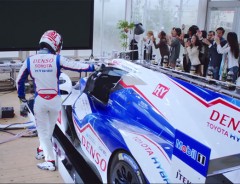
Source: © SkyDrive, Inc.
Toyota-backed SkyDrive successfully tests drone-like car. Are flying cars finally coming?
- Tags:
- Drone / flying car / SkyDrive / Toyota
Related Article
-

Power Unwasted: Watch How Toyota’s Race Car Makes Breakfast For 171 People[PR]
-

Rare sports car Toyota 2000GT makes a come back as limited edition wireless mouse
-

Sweeping Aerial Footage Shows The Beauty Of Kyoto’s Rural Side
-

Drone Captures Breathtaking Bird’s-Eye-View Of 800 Sakura Trees In Tokyo
-

Drones, Shamisen, and 16,500 LED Lights: A Spectacle Of Japan’s Modern Technology
-

From Grandpas to Virtual Currency: 5 Weirdly Themed Japanese Idol Groups


We’ve been waiting for flying cars for quite some time. The original Blade Runner, circa 1982, depicted flying cars incorporating seamlessly into the post-apocalyptic world of 2019. Although 2020, just a year later, did indeed turn out to be a modern-day hellscape, we unfortunately remain unable to cash in on the promise of aeronautic automobiles.
Yet, media and literature are filled with similar predictions that turned out to be wildly optimistic. Author Philip K. Dick originally predicted in 1968 that flying cars would be seen by the nineties. Back to the Future Part II also missed the mark in its depiction of a future 2015. In the film, director Robert Zemeckis imagined sky-high highways, futuristic medical devices, and hoverboards. We got hoverboards, only it wasn't what we expected…
Indeed, the history of the flying car is fraught with complications, to say the least. From the early ambitions of Henry Ford to more reasonable modern-day attempts, Donut Media covered the topic in a YouTube post:
Surprisingly, the notion of a flying car has been around for as long as the car, if not longer. Numerous aeronautic engineers have tried their hand at developing such a machine, leaving a long trail of abandoned prototypes in their wake. Henry Ford's attempt sadly resulted in the death of a friend. Other test-pilots have met similar fates.
SkyDrive’s Successful Test Flight
That’s why the buzz surrounding Toyota-backed SkyDrive is so engaging. In late August, the company documented a test flight of its SD-03 prototype flying car. The flight, which took place in the city of Toyota, demonstrated the versatility of the single-seat car equipped with eight rotary propellers. The manned-flight lasted several minutes and leveraged the flying car’s basic capabilities.
A so-called Vertical Take-Off and Landing (VTOL) vehicle, the SD-03 is relatively small. Taking up the space of about two cars, it incorporates eight motors in four locations around the chassis. The redundancy of motors helps ensure safe operation.
Although the successful test only rose to a height of about two meters, SkyDrive hopes to develop a two-seater prototype by 2023. The SD-03 model can fly for several minutes at low speeds. Engineers hope to increase the speed to 60 kph (40mph) and extend the flight duration to 30 minutes.
Nevertheless, SkyDrive may be in a fortuitous position. A main competitor in the flying car space, Uber recently announced a rollback of R&D on its ambitious Elevate project. The ride-sharing company teamed with NASA in 2016 as it set off to develop the airborne taxi project, which originally hoped to be operational by 2020. Yet, as the coronavirus wreaked havoc on the company and wider economy, the San Francisco based tech company announced that it would suspend the project, among others, as it shifts to bolstering income from its anemic flagship service.
2023 flying taxi service
In 2018, the Ministry of Economy, Trade, and Industry (METI) and Ministry of Land, Transport, and Tourism (MLTI) outlined a roadmap toward an "air mobility revolution." The plan outlines crucial requirements and goals behind an air taxi industry. It included experimental standards, use cases, and standards involving technological interoperability and safety measures. The governing bodies hope to commercialize the industry by 2023, with further development by 2030.
They included a conceptual video in their press release:
As you can see, the vision is bold but could usher in greater connectivity among rural communities and urban centers. In recent years, rural communities have been suffering from population collapse and resource shortages.
Mie Prefecture Governor Eikei Suzuki, a proponent of flying taxis and mobility as a service, applauds the government's foresight on the issue. His district is home to thriving industries, but residents struggle with transportation in the cut-off southern region. He told Forbes, “Mie Prefecture is like a microcosm of Japan because it has average population and size, primary and secondary industries, and so it has issues facing the other prefectures. If we can solve these issues here, they can be applied throughout Japan.”
While the program seems undoubtedly futuristic, Japan may be the perfect testing ground. It has one of the most robust and integrated transportation systems in the world. If it can be extended to the sky, residents may find themselves living in the future much earlier than imagined.